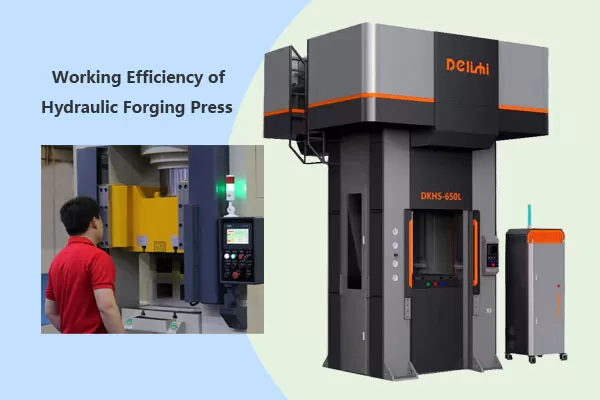Following is a structured breakdown of the key factors affecting the working efficiency of a hydraulic forging press, categorized for clarity.
1. Machine-Related Factors
Hydraulic System Performance
● Pump Efficiency (Gear vs. piston pumps, variable displacement)
● Pressure & Flow Stability (Fluctuations reduce consistency)
● Valve Responsiveness (Slow valves increase cycle time)
● Oil Quality & Temperature (High viscosity or overheating reduces efficiency)
Structural Integrity
● Frame Rigidity (Flexure under load causes misalignment)
● Ram Guidance System (Worn guides increase friction/deflection)
● Platen Parallelism (Non-parallel platens unevenly distribute force)
Power Transmission
● Seal Leakage (Internal leaks reduce effective pressure)
● Cylinder Friction (Worn seals/pistons decrease force output)

2. Tooling & Process Factors
Die Design & Condition
● Die Material (Tool steel vs. carbide wear resistance)
● Surface Finish (Rough surfaces increase friction/sticking)
● Lubrication Efficiency (Inadequate lubrication accelerates wear)
● Cooling Systems (Overheating causes thermal expansion/softening)
Workpiece Properties
● Material Hardness/Ductility (High-strength alloys require more force)
● Billet Size/Shape (Irregular geometries strain tooling)
● Temperature Consistency (Even in cold forging, slight variations matter)
Process Parameters
● Forging Speed (Too fast → defects; too slow → low output)
● Dwell Time (Excessive holding time wastes energy)
● Stroke Length Optimization (Unnecessary travel extends cycles)
3. Operational & Maintenance Factors
Maintenance Practices
● Preventive Maintenance (Scheduled checks for leaks/wear)
● Oil Contamination Control (Dirty oil damages pumps/valves)
● Bearing & Guide Lubrication (Reduces mechanical losses)
Human Factors
● Operator Skill (Improper setup increases scrap/cycle time)
● Loading/Unloading Speed (Manual handling slows throughput)
4. Energy & Control Systems
Energy Efficiency
● Regenerative Circuits (Recovers energy during ram retraction)
● Variable-Speed Pumps (Matches flow/pressure to demand)
● Heat Management (Coolers maintain optimal oil viscosity)
Automation & Control
● Closed-Loop Feedback (Real-time force/speed adjustments)
● PLC/CNC Integration (Precision in complex forging sequences)
● Predictive Analytics (AI-driven wear/performance monitoring)
5. External Factors
● Ambient Temperature (Affects oil viscosity/system cooling)
● Power Supply Stability (Voltage drops impact pump performance)
● Raw Material Consistency (Variations in billet quality require process tweaks)
Key Directions for Efficiency Improvement of Hydraulic Foging Press
Equipment Upgrades: Adopt servo hydraulic systems, high-rigidity frames, and automated loading/unloading.
Process Optimization: Tailor speed, pressure, and lubrication to material properties.
Intelligent Management: Use IoT for real-time equipment monitoring to shorten fault handling.
Mold Maintenance: Regularly inspect molds and use wear-resistant materials (e.g., CVD-coated molds) to extend life.
Systematic optimization of these factors can boost hydraulic forging press efficiency by 20%–40% while reducing reject rates and energy costs.


 +86-769-8306-1993
+86-769-8306-1993
 E-mail
E-mail
